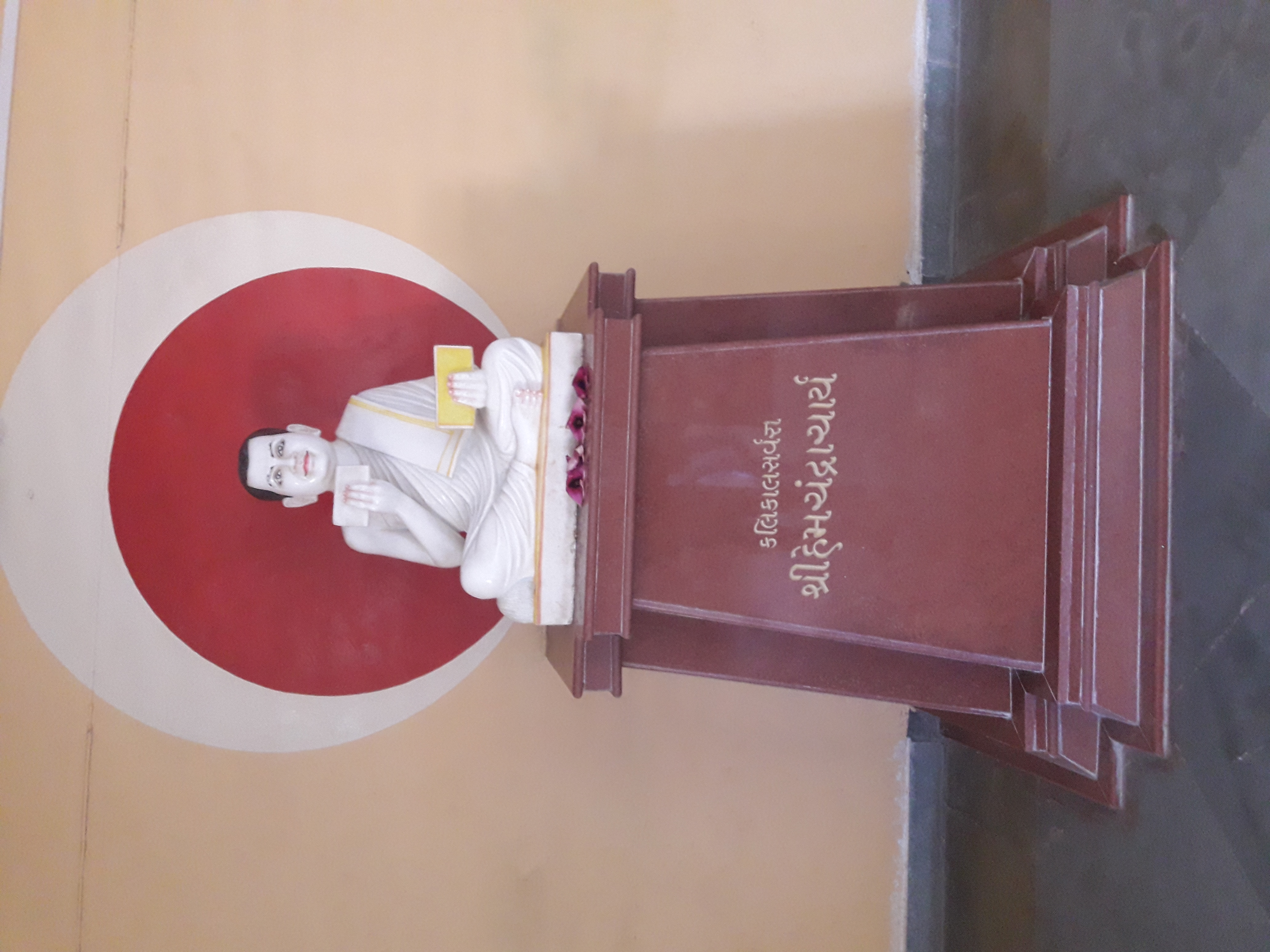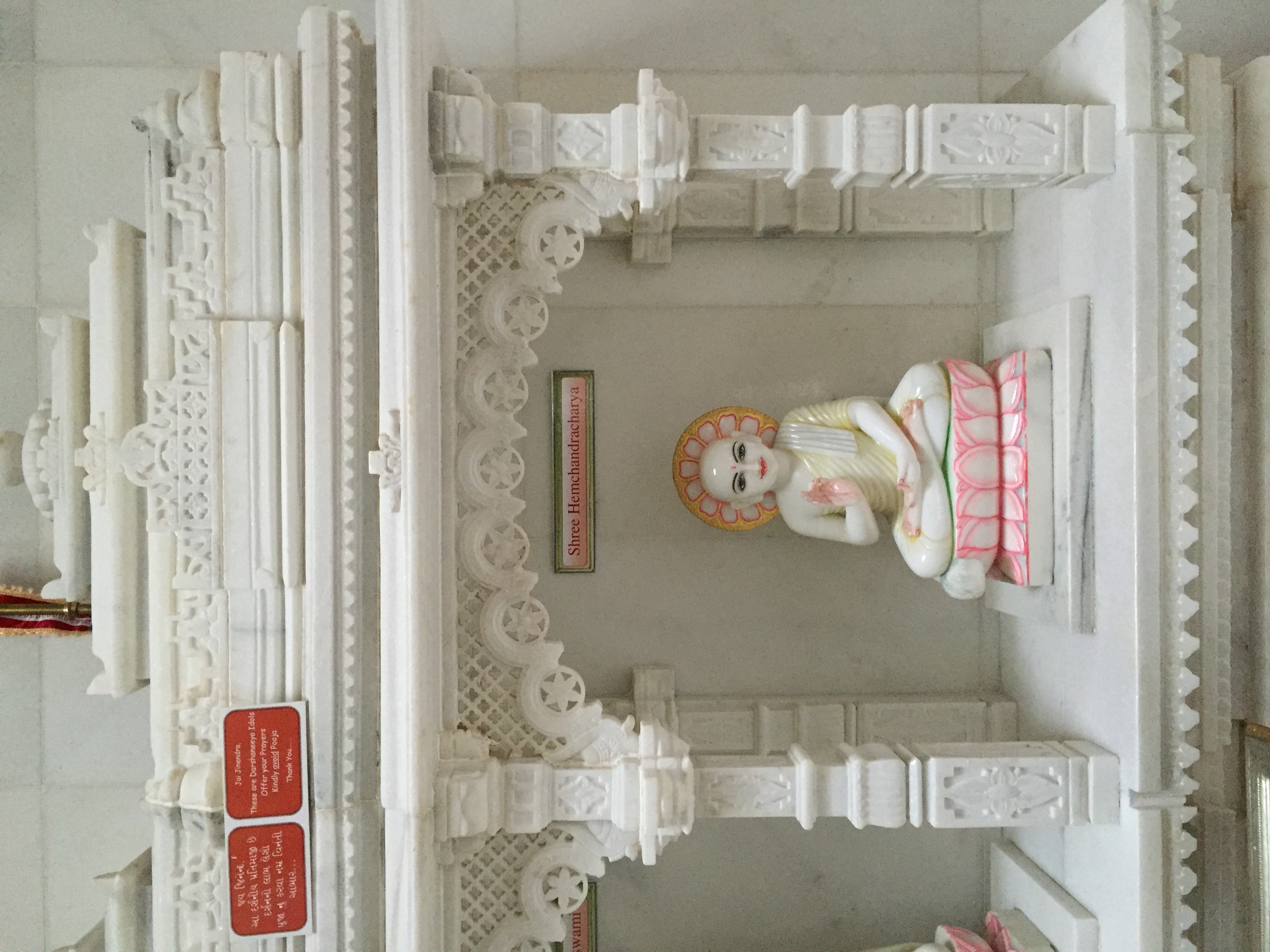|
Purva
The Fourteen Purva translated as ancient or prior knowledge, are a large body of Jain scriptures that was preached by all Tirthankaras (omniscient teachers) of Jainism encompassing the entire gamut of knowledge available in this universe. The persons having the knowledge of purvas were given an exalted status of ''Shrutakevali'' or "scripturally omniscient persons". Both the Jain traditions, Svetambara and Digambara hold that all the fourteen purvas have been lost.Jaini, Padmanabh (1998). ''The Jaina Path of Purification''. New Delhi: Motilal Banarsidass. . According to tradition, the Purvas were part of canonical literature and deposited in the third section of Drstivada (the twelfth and last canon). Knowledge of Purvas became fairly vulnerable after Mahavira's nirvana (liberation) and on account of effects of famine, such that, eventually only one person— Bhadrabahu Svami had a command over it. In accordance with the prophecy of Mahavira, the knowledge of Purvas died within 1, ... [...More Info...] [...Related Items...] OR: [Wikipedia] [Google] [Baidu] |
Drstivada
Drstivāda is a legendary lost text in the Jain religion. It is the last of the 12 Jain āgamas as per Śvetámbara tradition, said to be promulgated by Māhavīra himself and composed by Ganadhara Sudharmaswami. Drstivāda, translated as “Disputation about views”, was said to contain the entire knowledge of the Fourteen Purvas or prior knowledge that is now considered to be totally lost, in part because the tradition holds that the Drstivāda itself is also completely lost. However, its contents have been referred and explained in Nandi and ''Samavāyānga Sūtra''. Subject Matter of the Agama Dristivāda was divided into five parts :- #Parikarma #Sūtra #Pūrvanayoga #Purvgata #Chūlikā Parikarma contained Jaina calculatory science and the Sutra included discussions about creeds and doctrines. Pūrvanayoga contained Puranic narratives, religious biographies as well as illustrative tales. Purvagata contained fourteen subdivisions and contained discussions about ... [...More Info...] [...Related Items...] OR: [Wikipedia] [Google] [Baidu] |
Jain Agamas
Jain literature (Sanskrit: जैन साहित्य) refers to the literature of the Jain religion. It is a vast and ancient literary tradition, which was initially transmitted orally. The oldest surviving material is contained in the canonical ''Jain Agamas,'' which are written in Ardhamagadhi, a Prakrit ( Middle-Indo Aryan) language. Various commentaries were written on these canonical texts by later Jain monks. Later works were also written in other languages, like Sanskrit and Maharashtri Prakrit. Jain literature is primarily divided between the canons of the ''Digambara'' and ''Śvētāmbara'' orders. These two main sects of Jainism do not always agree on which texts should be considered authoritative. More recent Jain literature has also been written in other languages, like Marathi, Tamil, Rajasthani, Dhundari, Marwari, Hindi, Gujarati, Kannada, Malayalam and more recently in English. Beliefs The Jain tradition believes that their religion is eternal, and the ... [...More Info...] [...Related Items...] OR: [Wikipedia] [Google] [Baidu] |
Jain Texts
Jain literature (Sanskrit: जैन साहित्य) refers to the literature of the Jain religion. It is a vast and ancient literary tradition, which was initially transmitted orally. The oldest surviving material is contained in the canonical ''Jain Agamas,'' which are written in Ardhamagadhi, a Prakrit ( Middle-Indo Aryan) language. Various commentaries were written on these canonical texts by later Jain monks. Later works were also written in other languages, like Sanskrit and Maharashtri Prakrit. Jain literature is primarily divided between the canons of the ''Digambara'' and ''Śvētāmbara'' orders. These two main sects of Jainism do not always agree on which texts should be considered authoritative. More recent Jain literature has also been written in other languages, like Marathi, Tamil, Rajasthani, Dhundari, Marwari, Hindi, Gujarati, Kannada, Malayalam and more recently in English. Beliefs The Jain tradition believes that their religion is eternal, and the ... [...More Info...] [...Related Items...] OR: [Wikipedia] [Google] [Baidu] |
Jainism
Jainism ( ), also known as Jain Dharma, is an Indian religions, Indian religion. Jainism traces its spiritual ideas and history through the succession of twenty-four tirthankaras (supreme preachers of ''Dharma''), with the first in the current time cycle being Rishabhadeva, whom the tradition holds to have lived millions of years ago, the twenty-third ''tirthankara'' Parshvanatha, whom historians date to the 9th century BCE, and the twenty-fourth ''tirthankara'' Mahāvīra, Mahavira, around 600 BCE. Jainism is considered to be an eternal ''dharma'' with the ''tirthankaras'' guiding every time cycle of the Jain cosmology, cosmology. The three main pillars of Jainism are ''Ahimsa in Jainism, ahiṃsā'' (non-violence), ''anekāntavāda'' (non-absolutism), and ''aparigraha'' (asceticism). Jain monks, after positioning themselves in the sublime state of soul consciousness, take five main vows: ''ahiṃsā'' (non-violence), ''satya'' (truth), ''Achourya, asteya'' (not stealing), ''b ... [...More Info...] [...Related Items...] OR: [Wikipedia] [Google] [Baidu] |
Jain
Jainism ( ), also known as Jain Dharma, is an Indian religion. Jainism traces its spiritual ideas and history through the succession of twenty-four tirthankaras (supreme preachers of ''Dharma''), with the first in the current time cycle being Rishabhadeva, whom the tradition holds to have lived millions of years ago, the twenty-third ''tirthankara'' Parshvanatha, whom historians date to the 9th century BCE, and the twenty-fourth ''tirthankara'' Mahavira, around 600 BCE. Jainism is considered to be an eternal ''dharma'' with the ''tirthankaras'' guiding every time cycle of the cosmology. The three main pillars of Jainism are ''ahiṃsā'' (non-violence), ''anekāntavāda'' (non-absolutism), and '' aparigraha'' (asceticism). Jain monks, after positioning themselves in the sublime state of soul consciousness, take five main vows: ''ahiṃsā'' (non-violence), '' satya'' (truth), '' asteya'' (not stealing), ''brahmacharya'' (chastity), and '' aparigraha'' (non-possessiveness). Th ... [...More Info...] [...Related Items...] OR: [Wikipedia] [Google] [Baidu] |
Samavayanga Sutra
Samavayanga Sutra (c. 3rd-4th century BCE) is the 4th amongst the 12 Angas of the Jaina canon. The sutra is believed to have been composed by Gandhara Sudharmaswami. This ancient manuscript is the holy book of the Svetambara sect. This text contains the essence of Jain religion, defined and catalogued systematically. Written c. 300 BCE, it is a part of the collection of texts containing Lord Mahavira’s teachings, collectively termed as Agama Sutras. Subject matter of the Agama Samavayanga Sutra contains elements of mathematics and astronomy. One of the interesting aspects of this text is its portrayal of Monasticism and spirituality in the terms of numerology. Mathematics - The Samavayanga Sutra seems to be in continuation of the Sthananga Sutra and follows the numeric method of describing substances from 1 to 1 billion. Astronomy – It contains discussion on Mount Meru, the jyotishcakra, the Jambudvipa itself, the measurements used in the Jaina canon, the Jaina Loka ... [...More Info...] [...Related Items...] OR: [Wikipedia] [Google] [Baidu] |
Anekantavada
( hi, अनेकान्तवाद, "many-sidedness") is the Jain doctrine about metaphysical truths that emerged in ancient India. It states that the ultimate truth and reality is complex and has multiple aspects. According to Jainism, no single, specific statement can describe the nature of existence and the absolute truth. This knowledge ('' Kevala Jnana''), it adds, is comprehended only by the Arihants. Other beings and their statements about absolute truth are incomplete, and at best a partial truth. All knowledge claims, according to the ''anekāntavāda'' doctrine must be qualified in many ways, including being affirmed and denied. Anekāntavāda is a fundamental doctrine of Jainism. The origins of ''anekāntavāda '' can be traced back to the teachings of Mahāvīra (599–527 BCE), the 24th Jain . The dialectical concepts of ''syādvāda'' "conditioned viewpoints" and ''nayavāda'' "partial viewpoints" arose from ''anekāntavāda'' in the medieval era, providin ... [...More Info...] [...Related Items...] OR: [Wikipedia] [Google] [Baidu] |
Acharya Hemachandra
Hemachandra was a 12th century () Indian Jain saint, scholar, poet, mathematician, philosopher, yogi, grammarian, law theorist, historian, lexicographer, rhetorician, logician, and prosodist. Noted as a prodigy by his contemporaries, he gained the title ''kalikālasarvajña'', "the knower of all knowledge in his times" and ''father of Gujarati language''. Born as Changadeva, he was ordained in the Śvētāmbara school of Jainism in 1110 and took the name Somachandra. In 1125 he became an adviser to King Kumarapala and wrote ''Arhanniti'', a work on politics from a Jain perspective. He also produced ''Trishashti-shalaka-purusha-charita'' (“Deeds of the 63 Illustrious Men”), a Sanskrit epic poem on the history of important figures of Jainism. Later in his life, he changed his name to Hemachandra. Early life Hemachandra was born in Dhandhuka, in present-day Gujarat, on Kartika Sud Purnima (the full moon day of Kartika month). His date of birth differs according to sources ... [...More Info...] [...Related Items...] OR: [Wikipedia] [Google] [Baidu] |
Hermann Jacobi
Hermann Georg Jacobi (11 February 1850 – 19 October 1937) was an eminent German Indologist. Education Jacobi was born in Köln (Cologne) on 11 February 1850. He was educated in the gymnasium of Cologne and then went to the University of Berlin, where initially he studied mathematics, but later, probably under the influence of Albrecht Weber, switched to Sanskrit and comparative linguistics, which he studied under Weber and Johann Gildemeister. He obtained his doctorate from the University of Bonn. The subject of his thesis, written in 1872, was the origin of the term "hora" in Indian astrology. Jacobi was able to visit London for a year, 1872–1873, where he examined the Indian manuscripts available there. The next year, with Georg Buehler, he visited Rajasthan, India, where manuscripts were being collected. At Jaisalmer Library, he came across Jain Manuscripts, which were of abiding interest to him for the rest of his life. He later edited and translated many of the ... [...More Info...] [...Related Items...] OR: [Wikipedia] [Google] [Baidu] |
Hemachandra
Hemachandra was a 12th century () Indian Jain saint, scholar, poet, mathematician, philosopher, yogi, grammarian, law theorist, historian, lexicographer, rhetorician, logician, and prosodist. Noted as a prodigy by his contemporaries, he gained the title ''kalikālasarvajña'', "the knower of all knowledge in his times" and ''father of Gujarati language''. Born as Changadeva, he was ordained in the Śvētāmbara school of Jainism in 1110 and took the name Somachandra. In 1125 he became an adviser to King Kumarapala and wrote ''Arhanniti'', a work on politics from a Jain perspective. He also produced ''Trishashti-shalaka-purusha-charita'' (“Deeds of the 63 Illustrious Men”), a Sanskrit epic poem on the history of important figures of Jainism. Later in his life, he changed his name to Hemachandra. Early life Hemachandra was born in Dhandhuka, in present-day Gujarat, on Kartika Sud Purnima (the full moon day of Kartika month). His date of birth differs according to source ... [...More Info...] [...Related Items...] OR: [Wikipedia] [Google] [Baidu] |
Jambuswami
Jambuswami (543-449 BCE) was the spiritual successor of Sudharmaswami in Jain religious order reorganised by Mahavira. He remained the head for 39 or 44 years, after which he is believed to have gained '' Kevala Jnana'' (omniscience). He is believed to be the third and last '' kevali'' (omniscient being) after Mahavira in Jain tradition. He is believed to have attained ''moksha'' (liberated) at the age of 84 in Mathura. Jambu was succeeded by Prabhava (443-338 BCE), who was converted from a bandit by him. Prabhava was succeeded by Shayyambhava (377-315 BCE). Shayyambhava composed ''Dasavaikalika sutra'' after studying the fourteen ''purvas'' (pre-canonical texts). He was initiated as a Jain monk. He initiated his son as a monk at the age of eight and taught him sacred knowledge in 10 lectures in six months after which the latter died. Shayyambhava was succeeded by Yasobhadra (351-235 BCE), who was succeeded by his two disciples, Sambhutavijaya (347-257 BCE) and Bhadrabahu ... [...More Info...] [...Related Items...] OR: [Wikipedia] [Google] [Baidu] |
Sudharma Swami
Sudharmaswami ( sa, Sudharmāsvāmī or Sudharman; 607 BC – 507 BC) was the fifth ganadhara of Mahavira. All the current Jain acharyas and monks follow his rule. Life Sudharmaswami was the spiritual successor of Indrabhuti Gautama in religious order reorganised by Mahavira. He is traditionally dated from 607 to 506 BCE. He is believed in Jain tradition to have obtained omniscience after 12 years in 515 BC. He is believed to have attained nirvana in 507 BC at the age of 100. The leadership of religious order was then transferred to Jambuswami who served for 44 years and was the last Ghandhara who survived after kaal(death) of Mahavira For Jains, their scriptures represent the literal words of Mahavira and the other tirthankaras only to the extent that the agama is a series of beginning-less, endless and fixed truths, a tradition without any origin, human or divine, which in this world age has been channelled through Sudharmāsvāmī. See also * Jain monasticism Jain mo ... [...More Info...] [...Related Items...] OR: [Wikipedia] [Google] [Baidu] |






